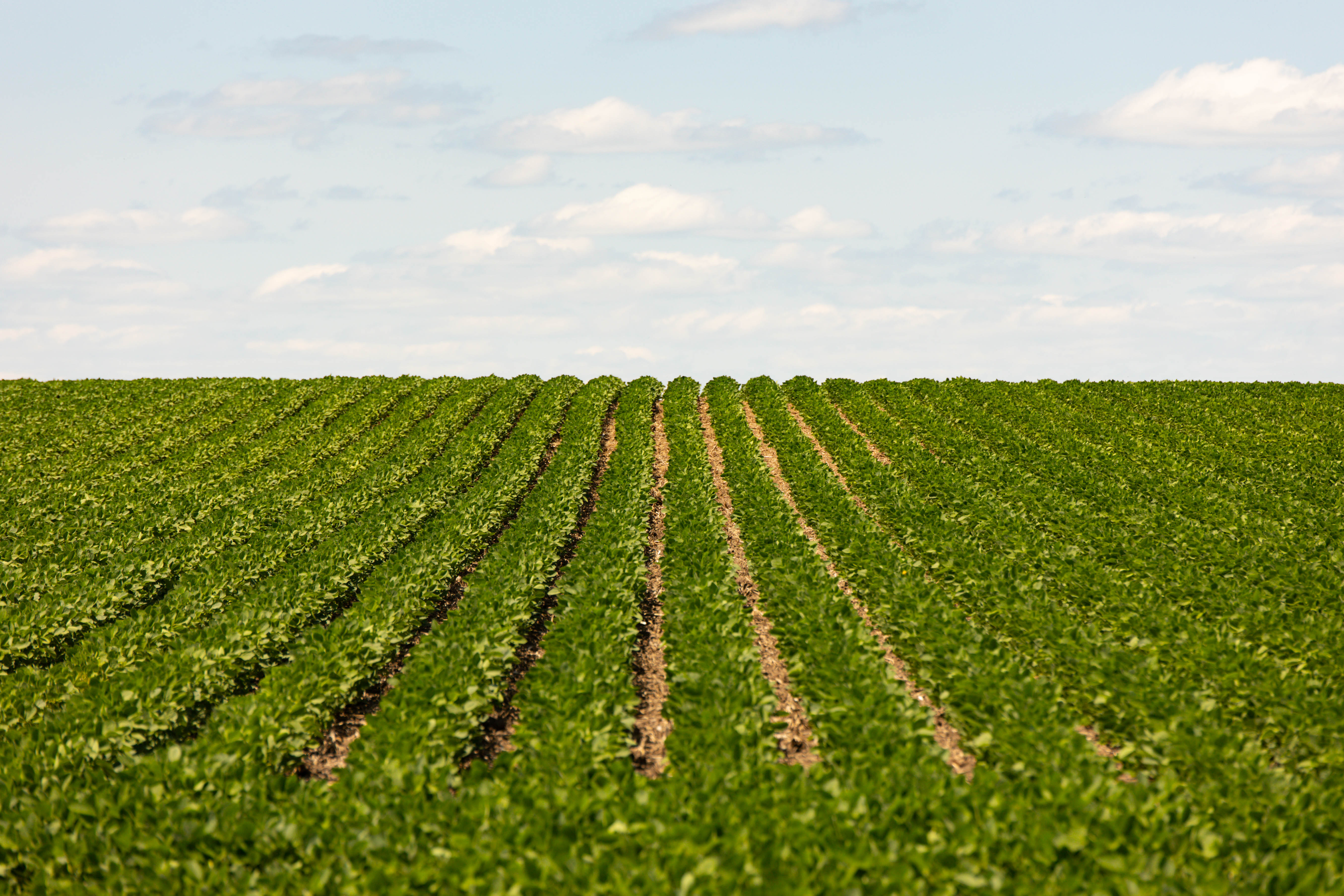
(Photo: Iowa Soybean Association / Joclyn Bushman)
Walking Rows: ISA agronomists update - August 1
August 1, 2024 | Kriss Nelson
Diseases and insect pressures are currently being kept below economic thresholds in most of the state. Farmers are being advised by Iowa Soybean Association (ISA) research agronomists to maintain their scouting efforts for diseases and pests during the later part of the season. If neighboring fields have been treated, it is important to note that these pests may migrate into untreated fields.
Drew Clemmensen – Northwest/Western Iowa
The soybean growth stages range from R3 to R4 and continue to improve from a slow, wet start. Timely rains should continue to help with pod set and fill.
Insects and disease pressure continue to be minimal in most fields I have been in, with grasshoppers being the most prevalent.
 Early Sudden Death Syndrome (SDS) leaf symptomology is starting to show. I advise going out into your fields to identify these spots now to understand its severity better so management decisions can be made for future soybean planting. By the time this disease fully develops on soybeans, it starts to overlap with the onset of the plant’s natural senescence process. It can easily be mistaken for the crop maturing, giving you a false read on its severity.
Early Sudden Death Syndrome (SDS) leaf symptomology is starting to show. I advise going out into your fields to identify these spots now to understand its severity better so management decisions can be made for future soybean planting. By the time this disease fully develops on soybeans, it starts to overlap with the onset of the plant’s natural senescence process. It can easily be mistaken for the crop maturing, giving you a false read on its severity.
Corn is currently in the reproductive stages R1 to R2 within my districts. Research indicates that after the R3 stages, the return on investment of fungicide application begins to decrease.
Tar Spot has reached levels in the state's west central and central regions where treatment may be warranted in some fields. Other diseases seem to stay below threshold levels. Continue to scout for disease pressure, and keep in mind that infestations from the ear leaf and up are of greater concern than those on the lower part of the plant.
Shane Beck – Northeast/Northern Iowa
While scouting soybean fields for diseases and insects in my area, I noticed some frogeye leaf spot starting to set and there has also been some pressure from Japanese beetles. Scouting for crop stage and pest pressure before applying fungicides and insecticides will give you a better idea of what is present and if there is an immediate need for treatment. Scouting field edges, especially those along neighbor’s fields and ditches, can indicate the potential insects moving into your fields.
 Corn Rootworm Trapping Survey is currently underway across the state, and most of the traps were placed two weeks ago. Four traps are placed in a row in a field within 200 feet between each trap and are changed every seven days. Early counts show little to no pressure in most fields being monitored. However, some Boone, Clayton, Cherokee, Crawford, Hardin and Humboldt County fields have seen high counts.
Corn Rootworm Trapping Survey is currently underway across the state, and most of the traps were placed two weeks ago. Four traps are placed in a row in a field within 200 feet between each trap and are changed every seven days. Early counts show little to no pressure in most fields being monitored. However, some Boone, Clayton, Cherokee, Crawford, Hardin and Humboldt County fields have seen high counts.
Since corn rootworm beetles do not migrate very far, it is important to scout or have a crop advisor do it for you so you know if there is any pressure and understand the options you have to mitigate the damage.
Mikaela Lawrence – Southwest/Western Iowa
The crops planted earlier are currently at the R3 stages, whereas the later-planted ones are entering the tasseling and flowering stages. Within the next few weeks, most fungicide applications will be concluded.
 While I have not identified any new pests or diseases, farmers should remain vigilant and continue monitoring to stay informed about the progress during the last phase of crop development.
While I have not identified any new pests or diseases, farmers should remain vigilant and continue monitoring to stay informed about the progress during the last phase of crop development.
Lucas De Bruin – Southeast/Eastern Iowa
Weather is the topic for my area this week. Parts of southeast and eastern Iowa have been receiving large amounts of rain, some accompanied by hail. Farmers should closely monitor the crops damaged by hail and consider applying a fungicide depending on their growth stage, as long as they haven't recently applied one.
 Soybeans should be at the R3 stage and receive fungicide if disease is present or if there is a history of disease. It is essential to monitor what is happening in the fields and make notes for reference for the next growing season.
Soybeans should be at the R3 stage and receive fungicide if disease is present or if there is a history of disease. It is essential to monitor what is happening in the fields and make notes for reference for the next growing season.
There have been reports of corn aphids. Farmers should be scouting for those and other later-season diseases.
Alex Schaffer – Central Iowa
August is a good time to begin preliminary yield checks and look for nutrient deficiencies. Although not much can be done to remedy the situation at this point in the growing season, it is wise to make notes and make changes for next season.
When examining nitrogen levels in corn, the presence of firing on the lower leaves may suggest a potential nitrogen deficiency. If a deficiency is observed, it can provide a snapshot of the amount lost from last fall’s anhydrous applications.
 For soybeans, sulfur is a nutrient most needed during reproductive phases. As a preface to our sulfur product soybean trials, we are surveying soybean plants to check for sulfur deficiencies.
For soybeans, sulfur is a nutrient most needed during reproductive phases. As a preface to our sulfur product soybean trials, we are surveying soybean plants to check for sulfur deficiencies.
Be vigilant when scouting later planted corn fields as they may become a trap crop. Insects will be attracted to fresh tassels and silks.
Back